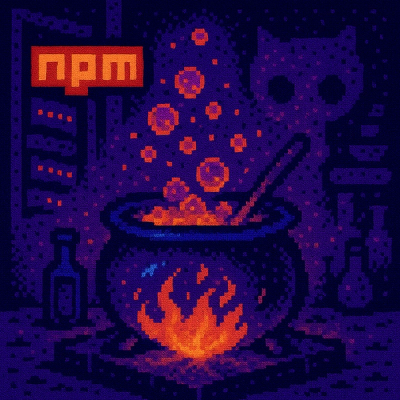
Research
/Security News
9 Malicious NuGet Packages Deliver Time-Delayed Destructive Payloads
Socket researchers discovered nine malicious NuGet packages that use time-delayed payloads to crash applications and corrupt industrial control systems.
SQL with Python in the middle
.. image:: https://img.shields.io/pypi/v/spyql.svg :target: https://pypi.org/project/spyql/ :alt: https://pypi.python.org/pypi/spyql
.. image:: https://readthedocs.org/projects/spyql/badge/?version=latest :target: https://spyql.readthedocs.io/en/latest/ :alt: https://spyql.readthedocs.io/en/latest/?version=latest
.. image:: https://codecov.io/gh/dcmoura/spyql/branch/master/graph/badge.svg?token=5C7I7LG814 :target: https://codecov.io/gh/dcmoura/spyql :alt: codecov
.. image:: https://pepy.tech/badge/spyql :target: https://pepy.tech/project/spyql :alt: downloads
.. image:: https://img.shields.io/badge/code%20style-black-000000.svg :target: https://github.com/psf/black :alt: code style: black
.. image:: https://img.shields.io/badge/License-MIT-yellow.svg :target: https://opensource.org/licenses/MIT :alt: license: MIT
.. intro_start
SPyQL is a query language that combines:
.. code-block:: sql
SELECT date.fromtimestamp(.purchase_ts) AS purchase_date, .price * .quantity AS total FROM json WHERE .department.upper() == 'IT' ORDER BY 2 DESC TO csv
SQL provides the structure of the query, while Python is used to define expressions, bringing along a vast ecosystem of packages.
SPyQL is fast and memory efficient. Take a look at the benchmarks with GB-size JSON data <https://colab.research.google.com/github/dcmoura/spyql/blob/master/notebooks/json_benchmark.ipynb>_.
SPyQL CLI ^^^^^^^^^
SPyQL offers a command-line interface that allows running SPyQL queries on top of text data (e.g. CSV, JSON). Data can come from files but also from data streams, such as as Kafka, or from databases such as PostgreSQL. Basically, data can come from any command that outputs text :-). More, data can be generated by a Python expression! And since SPyQL also writes to different formats, it allows to easily convert between data formats.
Take a look at the Command line examples to see how to query parquet, process API calls, transverse directories of zipped JSONs, convert CSV to JSON, and import JSON/CSV data into SQL databases, among many other things.
See also:
Tutorial (v0.8) <https://danielcmoura.com/blog/2022/spyql-cell-towers/>_
Demo video (v0.4) <https://vimeo.com/danielcmoura/spyqldemo>_
SPyQL Module ^^^^^^^^^^^^
SPyQL is also available as a Python module. In addition to the CLI features, you can also:
Principles ^^^^^^^^^^
We aim for SPyQL to be:
.. intro_end
Distinctive features of SPyQL ^^^^^^^^^^^^^^^^^^^^^^^^^^^^^
|
"I'm very impressed - this is some very neat pragmatic software design."
Simon Willison, Creator of Datasette, co-creator of Django
|
"I love this tool! I use it every day"...
Alin Panaitiu, Creator of Lunar
|
"Brilliant tool, thanks a lot for creating it and for the example here!"
Greg Sadetsky, Co-founder and CTO at Decibel Ads
|
The official documentation of SPyQL can be found at: <https://spyql.readthedocs.io/>_.
The easiest way to install SPyQL is from pip:
.. code-block:: sh
pip install spyql
.. hello_start
To test your installation run in the terminal:
.. code-block:: sh
spyql "SELECT 'Hello world' as Message TO pretty"
Output:
.. code-block::
Hello world
You can try replacing the output format by JSON or CSV, and adding more columns. e.g. run in the terminal:
.. code-block:: sh
spyql "SELECT 'Hello world' as message, 1+2 as three TO json"
Output:
.. code-block:: json
{"message": "Hello world", "three": 3}
.. hello_end
.. recipes_start
You can run the following example queries in the terminal:
spyql "the_query" < a_data_file
Example data files are not provided on most cases.
Query a CSV (and print a pretty table) ^^^^^^^^^^^^^^^^^^^^^^^^^^^^^^^^^^^^^^
.. code-block:: sql
SELECT a_col_name, 'positive' if int(col2) >= 0 else 'negative' AS sign FROM csv TO pretty
Convert CSV to a flat JSON ^^^^^^^^^^^^^^^^^^^^^^^^^^
.. code-block:: sql
SELECT * FROM csv TO json
Convert from CSV to a hierarchical JSON ^^^^^^^^^^^^^^^^^^^^^^^^^^^^^^^^^^^^^^^
.. code-block:: sql
SELECT {'client': {'id': col1, 'name': col2}, 'price': 120.40} AS json FROM csv TO json
or
.. code-block:: sql
SELECT {'id': col1, 'name': col2} AS client, 120.40 AS price FROM csv TO json
JSON to CSV, filtering out NULLs ^^^^^^^^^^^^^^^^^^^^^^^^^^^^^^^^
.. code-block:: sql
SELECT .client.id AS id, .client.name AS name, .price FROM json WHERE .client.name is not NULL TO csv
Explode JSON to CSV ^^^^^^^^^^^^^^^^^^^
.. code-block:: sql
SELECT .invoice_num AS id, .items.name AS name, .items.price AS price FROM json EXPLODE .items TO csv
Sample input:
.. code-block:: json
{"invoice_num" : 1028, "items": [{"name": "tomatoes", "price": 1.5}, {"name": "bananas", "price": 2.0}]} {"invoice_num" : 1029, "items": [{"name": "peaches", "price": 3.12}]}
Output:
.. code-block::
id, name, price 1028, tomatoes, 1.5 1028, bananas, 2.0 1029, peaches, 3.12
Python iterator/list/comprehension to JSON ^^^^^^^^^^^^^^^^^^^^^^^^^^^^^^^^^^^^^^^^^^
.. code-block:: sql
SELECT 10 * cos(col1 * ((pi * 4) / 90)) FROM range(80) TO json
or
.. code-block:: sql
SELECT col1 FROM [10 * cos(i * ((pi * 4) / 90)) for i in range(80)] TO json
Importing python modules ^^^^^^^^^^^^^^^^^^^^^^^^
Here we import hashlib to calculate a md5 hash for each input line.
Before running this example you need to install the hashlib package (\ pip install hashlib\ ).
.. code-block:: sql
IMPORT hashlib as hl SELECT hl.md5(col1.encode('utf-8')).hexdigest() FROM text
Getting the top 5 records ^^^^^^^^^^^^^^^^^^^^^^^^^
.. code-block:: sql
SELECT int(score) AS score, player_name FROM csv ORDER BY 1 DESC NULLS LAST, score_date LIMIT 5
Aggregations ^^^^^^^^^^^^
Totals by player, alphabetically ordered.
.. code-block:: sql
SELECT .player_name, sum_agg(.score) AS total_score FROM json GROUP BY 1 ORDER BY 1
Partial aggregations ^^^^^^^^^^^^^^^^^^^^
Calculating the cumulative sum of a variable using the PARTIALS modifier. Also demoing the lag aggregator.
.. code-block:: sql
SELECT PARTIALS .new_entries, sum_agg(.new_entries) AS cum_new_entries, lag(.new_entries) AS prev_entries FROM json TO json
Sample input:
.. code-block:: json
{"new_entries" : 10} {"new_entries" : 5} {"new_entries" : 25} {"new_entries" : null} {} {"new_entries" : 100}
Output:
.. code-block:: json
{"new_entries" : 10, "cum_new_entries" : 10, "prev_entries": null} {"new_entries" : 5, "cum_new_entries" : 15, "prev_entries": 10} {"new_entries" : 25, "cum_new_entries" : 40, "prev_entries": 5} {"new_entries" : null, "cum_new_entries" : 40, "prev_entries": 25} {"new_entries" : null, "cum_new_entries" : 40, "prev_entries": null} {"new_entries" : 100, "cum_new_entries" : 140, "prev_entries": null}
If PARTIALS was omitted the result would be equivalent to the last output row.
Distinct rows ^^^^^^^^^^^^^
.. code-block:: sql
SELECT DISTINCT * FROM csv
To run the following examples, type Ctrl-x Ctrl-e on you terminal. This will open your default editor (emacs/vim). Paste the code of one of the examples, save and exit.
Queries on Parquet with directories ^^^^^^^^^^^^^^^^^^^^^^^^^^^^^^^^^^^
Here, find transverses a directory and executes parquet-tools for each parquet file, dumping each file to json format. jq -c makes sure that the output has 1 json per line before handing over to spyql. This is far from being an efficient way to query parquet files, but it might be a handy option if you need to do a quick inspection.
.. code-block:: sh
find /the/directory -name "*.parquet" -exec parquet-tools cat --json {} ; | jq -c | spyql " SELECT .a_field, .a_num_field * 2 + 1 FROM json "
Querying multiple json.gz files ^^^^^^^^^^^^^^^^^^^^^^^^^^^^^^^
.. code-block:: sh
gzcat *.json.gz | jq -c | spyql " SELECT .a_field, .a_num_field * 2 + 1 FROM json "
Querying YAML / XML / TOML files ^^^^^^^^^^^^^^^^^^^^^^^^^^^^^^^^
yq <https://kislyuk.github.io/yq/#>_ converts yaml, xml and toml files to json, allowing to easily query any of these with spyql.
.. code-block:: sh
cat file.yaml | yq -c | spyql "SELECT .a_field FROM json"
.. code-block:: sh
cat file.xml | xq -c | spyql "SELECT .a_field FROM json"
.. code-block:: sh
cat file.toml | tomlq -c | spyql "SELECT .a_field FROM json"
Kafka to PostegreSQL pipeline ^^^^^^^^^^^^^^^^^^^^^^^^^^^^^
Read data from a kafka topic and write to postgres table name customer.
.. code-block:: sh
kafkacat -b the.broker.com -t the.topic | spyql -Otable=customer -Ochunk_size=1 --unbuffered " SELECT .customer.id AS id, .customer.name AS name FROM json TO sql " | psql -U an_user_name -h a.host.com a_database_name
Monitoring statistics in Kafka ^^^^^^^^^^^^^^^^^^^^^^^^^^^^^^
Read data from a kafka topic, continuously calculating statistics.
.. code-block:: sh
kafkacat -b the.broker.com -t the.topic | spyql --unbuffered " SELECT PARTIALS count_agg(*) AS running_count, sum_agg(value) AS running_sum, min_agg(value) AS min_so_far, value AS current_value FROM json TO csv "
Sub-queries (piping) ^^^^^^^^^^^^^^^^^^^^
A special file format (spy) is used to efficiently pipe data between queries.
.. code-block:: sh
cat a_file.json | spyql " SELECT ' '.join([.first_name, .middle_name, .last_name]) AS full_name FROM json TO spy" | spyql "SELECT full_name, full_name.upper() FROM spy"
(Equi) Joins ^^^^^^^^^^^^^
It is possible to make simple (LEFT) JOIN operations based on dictionary lookups.
Given numbers.json:
.. code-block:: json
{ "1": "One", "2": "Two", "3": "Three" }
Query:
.. code-block:: sh
spyql -Jnums=numbers.json " SELECT nums[col1] as res FROM [3,4,1,1] TO json"
Output:
.. code-block:: json
{"res": "Three"} {"res": null} {"res": "One"} {"res": "One"}
If you want a INNER JOIN instead of a LEFT JOIN, you can add a criteria to the where clause, e.g.:
.. code-block:: sql
SELECT nums[col1] as res FROM [3,4,1,1] WHERE col1 in nums TO json
Output:
.. code-block:: json
{"res": "Three"} {"res": "One"} {"res": "One"}
Queries over APIs ^^^^^^^^^^^^^^^^^
.. code-block:: sh
curl https://reqres.in/api/users?page=2 | spyql " SELECT .data.email AS email, 'Dear {}, thank you for being a great customer!'.format(.data.first_name) AS msg FROM json EXPLODE .data TO json "
Plotting to the terminal ^^^^^^^^^^^^^^^^^^^^^^^^
.. code-block:: sh
spyql " SELECT col1 FROM [10 * cos(i * ((pi * 4) / 90)) for i in range(80)] TO plot "
Plotting with matplotcli <https://github.com/dcmoura/matplotcli>_
^^^^^^^^^^^^^^^^^^^^^^^^^^^^^^^^^^^^^^^^^^^^^^^^^^^^^^^^^^^^^^^^^^^^
.. code-block:: sh
spyql " SELECT col1 AS y FROM [10 * cos(i * ((pi * 4) / 90)) for i in range(80)] TO json " | plt "plot(y)"
.. image:: imgs/matplotcli_demo1.png :width: 600 :alt: matplotcli demo
.. recipes_end
This package was created with Cookiecutter <https://github.com/audreyr/cookiecutter>_ and the audreyr/cookiecutter-pypackage project template <https://github.com/audreyr/cookiecutter-pypackage>_.
FAQs
SPyQL: SQL with Python in the middle
We found that spyql demonstrated a healthy version release cadence and project activity because the last version was released less than a year ago. It has 1 open source maintainer collaborating on the project.
Did you know?

Socket for GitHub automatically highlights issues in each pull request and monitors the health of all your open source dependencies. Discover the contents of your packages and block harmful activity before you install or update your dependencies.

Research
/Security News
Socket researchers discovered nine malicious NuGet packages that use time-delayed payloads to crash applications and corrupt industrial control systems.

Security News
Socket CTO Ahmad Nassri discusses why supply chain attacks now target developer machines and what AI means for the future of enterprise security.

Security News
Learn the essential steps every developer should take to stay secure on npm and reduce exposure to supply chain attacks.